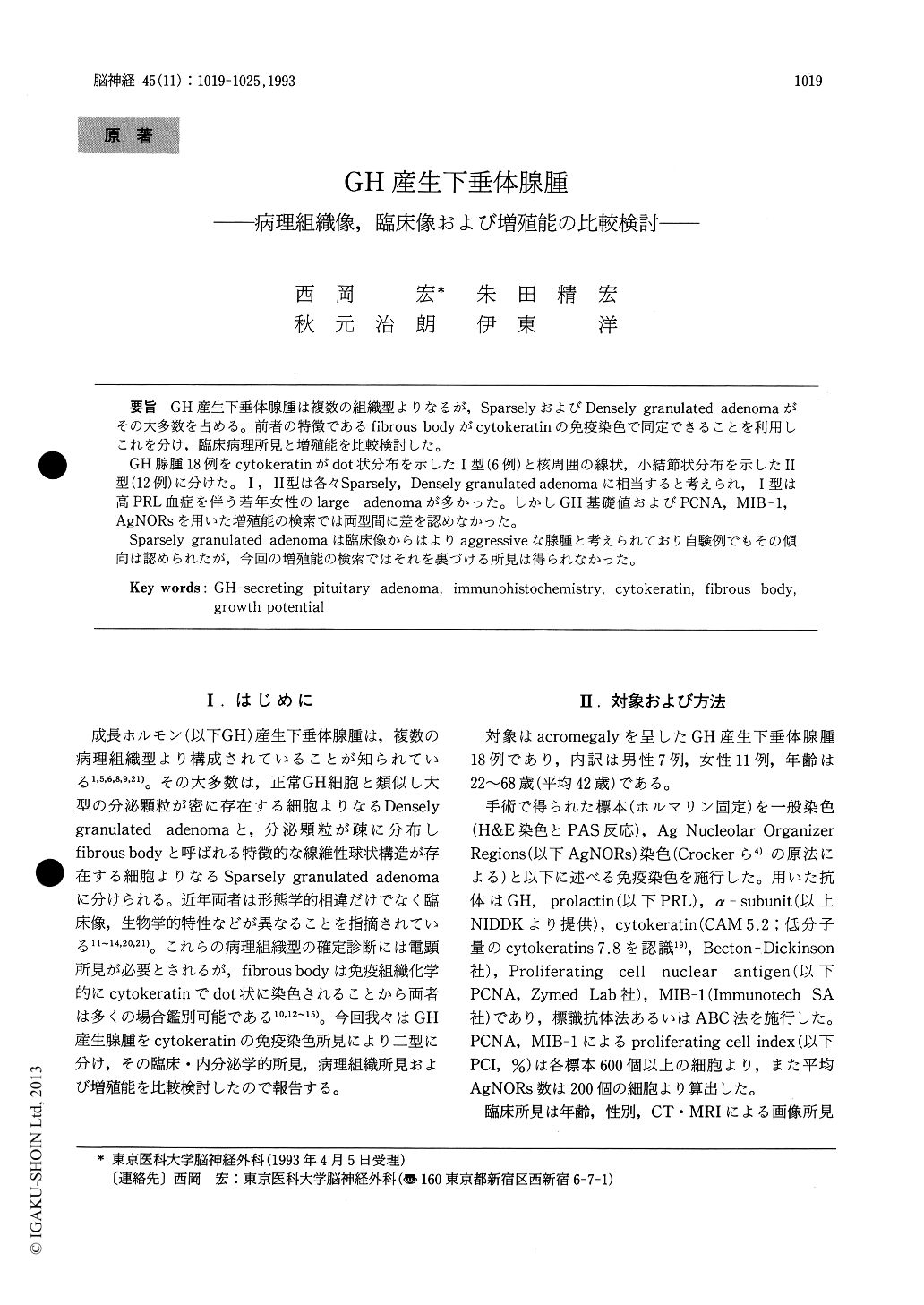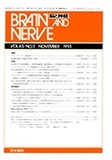Japanese
English
- 有料閲覧
- Abstract 文献概要
- 1ページ目 Look Inside
GH産生下垂体腺腫は複数の組織型よりなるが,SparselyおよびDensely granulated adenomaがその大多数を占める。前者の特徴であるfibrous bodyがcytokeratinの免疫染色で同定できることを利用しこれを分け,臨床病理所見と増殖能を比較検討した。
GH腺腫18例をcytokeratinがdot状分布を示した1型(6例)と核周囲の線状,小結節状分布を示したII型(12例)に分けた。1,II型は各々Sparsely, Densely granulated adenomaに相当すると考えられ,1型は高PRL血症を伴う若年女性の1arge adenomaが多かった。しかしGH基礎値およびPCNA, MIB−1,AgNORsを用いた増殖能の検索では両型間に差を認めなかった。
Sparsely granulated adenomaは臨床像からはよりaggressiveな腺腫と考えられており自験例でもその傾向は認められたが,今回の増殖能の検索ではそれを裏づける所見は得られなかった。
We compared clinical features, including endo-crinological and radiological findings, histological features and the proliferative parameters (PCNA, MIB-1 and AgNORs) with immunohistochemical features in growth hormone (GH) secreting pitui-tary adenomas.
18 cases were divided into two groups based on immunohistochemical intracytoplasmic stainings for cytokeratin: a prominent dot-like pattern (group I, 6 cases) and a diffuse perinuclear pattern (group II, 12 cases). Patients in group I (6 females, m=37.6 years old) were younger, showed female predominancy and had a shorter history of acromegaly compared with patients in group II (7 males, 5 females, m=44.9 years old). Although the size of the adenomas tend to be larger in group I, no difference was recognized in plasma GH levels between the two groups. Increased serum prolactin (PRL) levels were accompanied more common in group I. Abnormal GH responses to TRH and LHRH injection and GH suppressions to bromo-criptine administration were more frequently noted in group II than group I. Surgical approaches were transcranial in most cases of group I and trans-sphenoidal in group II. There was no difference in surgical results as to the correction rate of GH levels between the two groups. Histopathologically, group I adenomas were mostly chromophobic, weakly positve for GH, and were generally negative for PRL and α-subunit. On the other hand, group II adenomas were mostly acidophilic, diffusely stained for GH, and were often positive for PRL and α- subunit. However, there was no significant differe-nce in proliferating parameters between the two groups.
GH secreting pituitary adenomas are known to be divided into at least two distinct subtypes according to intracytoplasmic cytokeratin distribution pat-tern. A dot-like staining of group I in our study seems to correspond to fibrous bodies, the most conspicuous morphologic marker of sparsely granulated GH adenoma, while group II adenomas are likely to be consistent with densely granulated GH adenoma. Many authors reported that sparsely granulated adenomas are larger, more aggressive, more invasive, and have a lower surgical cure rate, however, no difference were seen in proliferating parameters in our study. This convenient classifica-tion of GH secreting adenomas using immunohisto-chemistry for cytokeratin may be useful for clini-cians for assessing prognosis and making therapeu-tic decisions for residual or reccurent adenomas.

Copyright © 1993, Igaku-Shoin Ltd. All rights reserved.


